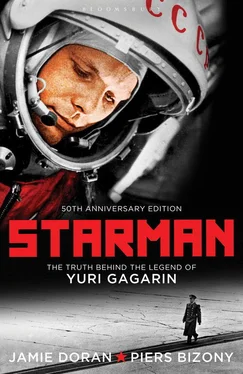Tsinev kept hold of the document and it was never seen again. Within weeks, Fadyekin was transferred to a junior consular office in Iran, merely for the crime of glancing through it. Makharov was fired immediately, without a pension, and Tsinev took over as chief of an entire counter-intelligence department. Russayev was stripped of any responsibility for space affairs, and transferred to an insignificant staff training department outside Moscow, well away from the Lubyanka. ‘I kept my head down like a hermit for the next ten years,’ he says.
Early on the morning of April 23, 1967, the Soyuz was propped up against the gantry at Baikonur, ready for launch, according to the original schedule. As Komarov made his final preparations before taking the lift up to his seat in the capsule, Gagarin seemed to have forgotten that the torture inflicted on back-up pilots in the old Vostok days no longer applied. Instead of forcing them into spacesuits and driving them all the way to the base of the pad to watch their more fortunate colleagues ascend to the top of the rocket, back-ups were now stood down from duty the night before a flight – only this time, Komarov was not necessarily the more fortunate man. The journalist Yaroslav Golovanov noticed Gagarin behaving very strangely. ‘He demanded to be put into the protective spacesuit. It was already clear that Komarov was perfectly fit to fly, and there were only three or four hours remaining until lift-off time, but he suddenly burst out and started demanding this and that. It was a sudden caprice.’ Golovanov did not realize that this was not random misbehaviour. Russayev and others insist that Gagarin was trying to elbow his way onto the flight in order to save Komarov from almost certain death.
The problem with Golovanov’s version is that Komarov was not supposed to wear a spacesuit for this mission; therefore his back-up, Gagarin, would not have been assigned a suit, either. The front module of the Soyuz incorporated airtight hatches at each end, allowing the module to serve as an airlock. The spacewalkers from the second Soyuz needed their suits, but Komarov did not. In which case, why did Gagarin demand to be dressed in a suit? A more realistic explanation is that he wanted Komarov to wear the spacesuit in order to give him an extra safety margin. This is not as simple as it sounds; spacesuits are so much an integral part of a capsule’s system that they cannot always be worn with the simplicity of an overcoat, but have to be plugged in to other life-support machinery. Another possibility is that Gagarin was trying to disrupt the preparations somehow, but without any clear plan of action. Whatever happened in the suiting-up room that morning, the archive pre-launch footage shows an unhappy Komarov, a downcast Gagarin and some very subdued technicians.
Komarov encountered problems almost as soon as he had achieved orbit. One of the two solar-power vanes on the rear equipment module refused to deploy (yet another mechanical problem) and his guidance computers ran short of power. Launch of the second Soyuz, crewed by Yeliseyev, Khrunov and Bykovsky, was cancelled while ground controllers worked on Komarov’s power deficit, although by some accounts Vasily Mishin held off cancelling the second launch for as long as he could. After eighteen orbits (twenty-six hours), Komarov’s problems had not been resolved, and the mission directors decided to terminate the mission altogether during the next orbit. Komarov had great difficulty lining up his capsule for re-entry and complained, ‘This devil ship! Nothing I lay my hands on works properly.’
Unlike the old Vostok ball, the Soyuz capsule had a distinctly flattened underside to give it some aerodynamic lift in the atmosphere, rather like an Apollo module. The drawback was that it had to be aimed much more accurately than Vostok. With his guidance systems almost entirely off-line, Komarov could not keep his ship at a stable angle, and when it began to spin, he fired his attitude control jets to try and bring it back in hand. Unfortunately the OKB-1 designers had put the thrusters too close alongside the star tracker navigation sensors, and the delicate lenses could no longer tell stars from random reflections. Passing over the night side of earth, and searching for a more obvious reference target for his blurred instruments, Komarov had to use the moon in a desperate attempt to work out his alignment. [7] Detailed technical accounts of the possible sequence of failures during Komarov’s flight can be found in Newkirk, Dennis, Almanac of Soviet Manned Spaceflight , pp. 58–64. See also: Hooper, The Soviet Cosmonaut Team , Vol. II, pp. 133–6; Harvey, The New Russian Space Programme , pp. 107–10;Gatland, Kenneth, ‘The Soviet Space Programme After Soyuz 1’, Spaceflight magazine, Vol. 9, No. 9, 1967, pp. 298–9; Shepard & Slayton, Moonshot , pp. 250–53.
Rumours about the dialogue between Komarov and ground control have circulated for many years, based on reports from American National Security Agency (NSA) staff monitoring the radio signals from a USAF facility near Istanbul. In August 1972 a former NSA analyst, interviewed under the name ‘Winslow Peck’ (real name Perry Fellwock), gave a very moving account of the interception:
They knew they had problems for about two hours before Komarov died, and were fighting to correct them. We taped [the dialogue] and listened to it a couple of times afterwards. Kosygin called Komarov personally. They had a video-phone conversation, and Kosygin was crying. He told him he was a hero… The guy’s wife got on too, and they talked for a while. He told her how to handle their affairs, and what to do with the kids. It was pretty awful. Towards the last few minutes, he was falling apart… The strange thing is, we were all pretty bummed-out by the whole thing. In a lot of ways, having the sort of job we did humanizes the Russians. You study them so much, and listen to them for so many hours, that pretty soon you come to know them better than your own people. [8] The interview, under the headline ‘US Electronic Espionage: a Memoir’, was published in the left-leaning American journal Ramparts , which went out of business in 1980. According to a senior source in the US State Department, the National Security Agency (NSA) considered prosecuting Fellwock. He could have been imprisoned, but the case was dropped because the NSA did not want to admit in open court to their radio monitoring of Soviet space communications.
As he began his descent into the atmosphere, Komarov knew he was in terrible trouble. The radio outposts in Turkey intercepted his cries of rage and frustration as he plunged to his death, cursing for ever the people who had put him inside a botched spaceship – although his ‘final screams’, mentioned later in Fellwock’s account, may be an exaggeration.
Korolev’s inadvertent prophesy about ‘flying under rags’ was fulfilled when the parachutes did not deploy properly. A small drogue canopy came out, but failed to pull the bigger canopy from its storage bay – yet another serious design flaw. A back-up parachute was released, only to become entangled with the first drogue. There was nothing to slow the capsule’s fall, and Komarov slammed onto the steppe near Orenburg with all the force of an unrestrained 2.8-ton meteorite. The capsule was utterly flattened, and the buffer retro-rockets in its base blew up on impact, burning what little wreckage was left.
Recovery troops picked up handfuls of soil to try and dampen the flames. Their radio messages back to base were garbled and distressed: something about the cosmonaut ‘requiring urgent medical attention’. It seems unlikely that any recognizable portion of Komarov’s body would have survived intact, although Russayev says that a heel bone was found among the ashes.
Читать дальше












